Pasta Versatility: How to Make and Use Homemade Pasta

I love all things food, from picnics to paella to peaches and now, my latest obsession is pasta.
I love teaching Pasta Workshop at The Chopping Block because we show students how to make their own pasta dough, roll it out with a pasta machine into different shapes and sizes and serve it with traditional sauces. Some of those sauces are overflowing with cheesy goodness and others are more simplified and a bit lighter for warmer seasons.
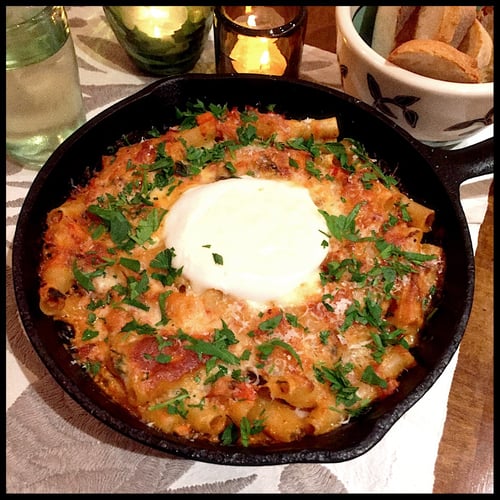 Baked Ziti with tomato sauce and diced vegetables, ricotta, mozzarella and melted burrarta in the center of a cast iron pan
Baked Ziti with tomato sauce and diced vegetables, ricotta, mozzarella and melted burrarta in the center of a cast iron pan
One of the most interesting things about pasta that you may not know is the reason for the numerous shapes and sizes. The pasta shape will determine if it is suited for stuffing with ground meats, cheese or vegetables, such as cannelloni or manicotti. Some shapes and sizes are best added to soups like orzo or rosa marina. Some have ridges that help soak up and catch pieces of a rich meaty tomato sauce, like bucatini, penne or rigatoni. One of my favorite types of pasta is pappardelle. Its flat, long and wide shape makes it the perfect choice for robust sauces such as a meaty and rich Bolognese. I also like the fact that the name pappardelle means “to gulp down.” Another of my favorite pastas is manicotti, which means “little muffs.”
Pasta exists in many forms and from many countries. The Germans have spaetzle. The Poles have pierogi. In Asia, there are dozens of noodles that are usually made with rice, wheat or soy flour. The Italian word pasta means “paste” and it refers to a dough made by combining durum wheat flour and semolina with a liquid, usually water, milk or eggs.
Making your own pasta dough and rolling it out using a pasta machine or by using a rolling pin is one of most mind blowing, fun experiences you can ever have!
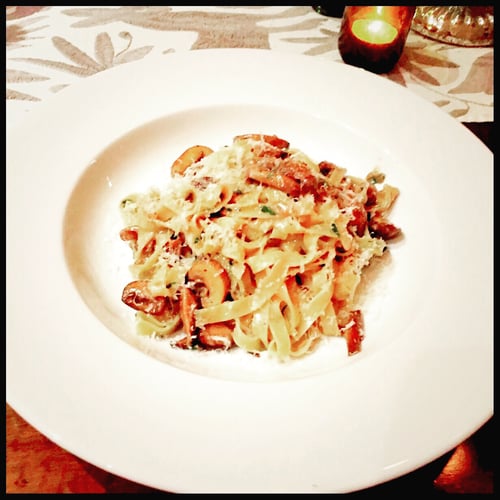 Fettucine in a sauce of balsamic vinegar, shallot, heavy cream, sliced shitake and baby portabello mushrooms
Fettucine in a sauce of balsamic vinegar, shallot, heavy cream, sliced shitake and baby portabello mushrooms
You can make pasta dough in a food processor, or if you want to go old school Italian grandmother, you can make it by hand on your kitchen countertop. First place your flour, semolina and salt in a mound on your countertop. Then make a well in the center of the mound. Place the cracked, whole eggs in the center of the mound and with a fork gently stir and fold your dry ingredients into the eggs until you’ve formed a compact dough. Knead the pasta dough for about 5-10 minutes, until it’s nice and smooth. Next roll it into a ball and cover with plastic wrap. You can let the fresh pasta sit on your work surface for up to an hour while covered in plastic wrap, or you can place it in the refrigerator for up to 1 to 2 days. Just make sure to bring it up to room temperature before rolling out your dough.
I always tell my students to go for anything that can make your work easier in the kitchen, so why not use a food processor to make pasta dough? After all, we also use it for pie dough and pizza dough.
Fresh Pasta Dough
Yield: 4 servings as an entrée or 8 servings as an appetizer
Active time: 20 minutes
Start to finish: 40 minutes
2 cups unbleached all-purpose flour
1/4 cup semolina
3 eggs
1 to 2 tablespoons water
- Place the dry ingredients in the bowl of a food processor.
- Add eggs and 1 tablespoon water, and process until well combined.
- Test dough to make sure it will hold together. If it is dry, add up to a tablespoon more water as needed to make the dough moist but not sticky.
- Turn dough out and knead for 1 to 2 minutes until dough is smooth.
- Wrap the dough tightly in plastic, and allow it to rest at least 20 minutes.
- Roll out in a pasta maker until smooth, then roll into sheets and cut into desired noodles.
- To cook and serve, plunge into rapidly boiling salted water, cook until tender, about 2 minutes, and serve at once with your favorite sauce.
NOTE: Pasta dough can be stored in the refrigerator for 1 to 2 days. Allow it to come up to room temperature before rolling out. Pasta that has been rolled and shaped can be frozen. You can also set shaped pasta out on towels until completely dry, and then it can be stored in an airtight container at room temperature.
One of my favorite pasta dough rolling machines is the Marcato Atlas. Here it is along with a batch of freshly made pasta dough that has already rested.
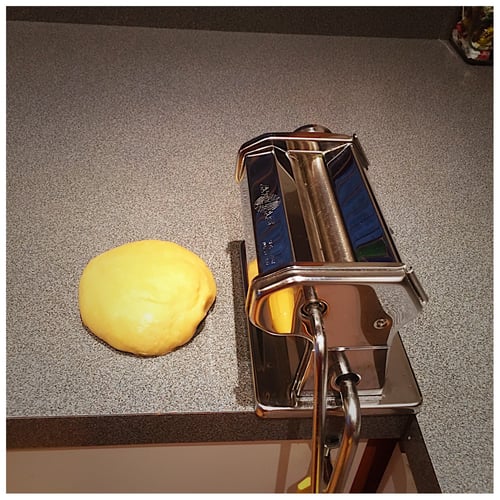
As cool and rewarding as it is making your own pasta dough, there is nothing wrong about buying dried pasta as well. There are some that are just as tasty as ones created by hand. If there happens to be a supermarket or an Italian deli in your neighborhood that makes fresh cut pasta, go for it! I’m lucky to have one of those in my neighborhood, and I take full advantage of it.
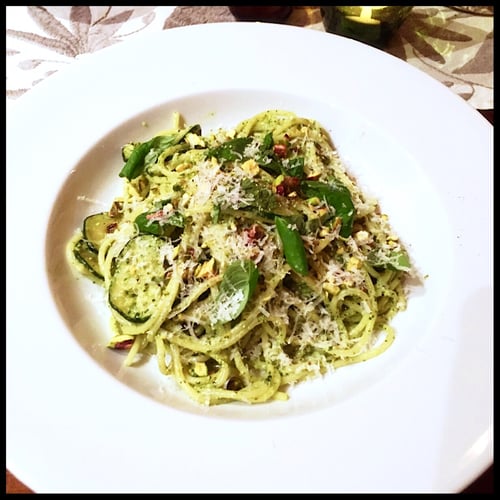
Spaghetti in a mint, parsley, spinach, kale and pistachio pesto with thinly sliced sautéed zucchini and garnished with torn mint, basil, grated Parmesan and chopped pistachios
I love creating extravagant pasta dishes like lasagna. Sometimes I make lasagna with a hearty meat sauce and other times with a simple tomato sauce and a few sautéed veggies. But regardless of the sauce I decide on, it will have rich layers of ricotta, egg, parsley and Parmesan in between the layers of sauce that goes best depending on which lasagna I’m baking.
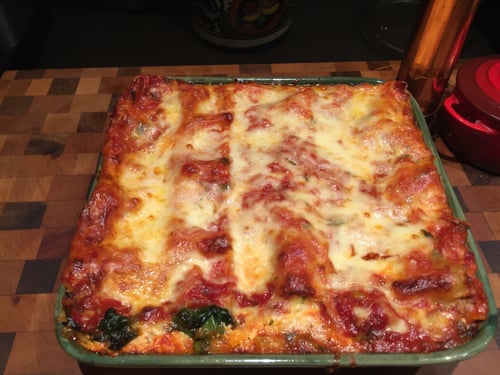
Lately my favorite pasta dishes have been those that are a bit more simplified, those that use very fresh and few ingredients, that don’t take up a lot of time in the kitchen. This pappardelle pasta was prepared in a sauce of nothing but olive oil, garlic, blistered heirloom baby grape tomatoes, baby spinach, torn basil and some crushed red pepper flakes and finished with a few shavings of Parmesan Reggiano cheese.
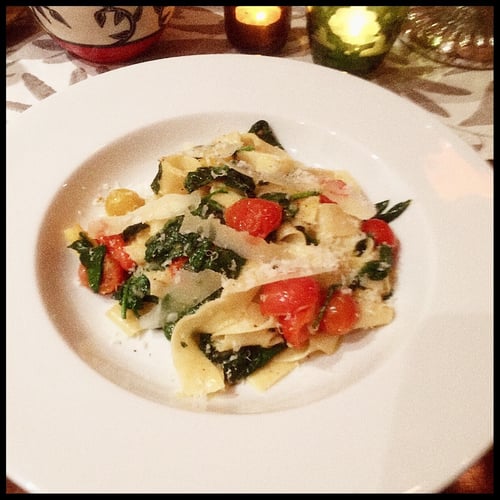
I’ve been experimenting and creating a new pasta dish practically once a week. Last night, I made homemade raviolis that had a filling of ricotta cheese, sautéed spinach, leeks and garlic.
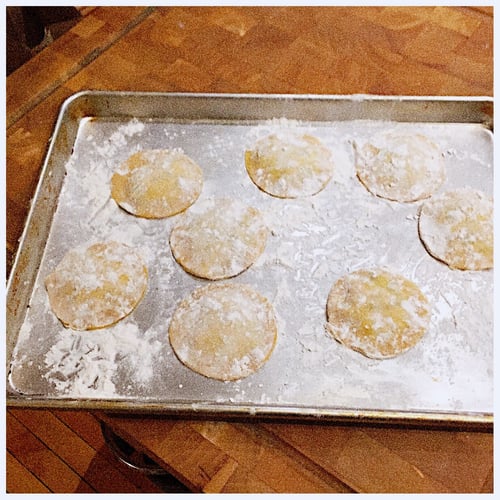
They were placed on a pool of marinara sauce along with a few spoonfuls of the sauce drizzled on top and finished with a few drops of extra-virgin olive oil. I garnished it with a chiffonade of fresh basil, grated Parmesan cheese and a bit of crispy pancetta. The pancetta added a crispy texture with the flavors of smoke, salt and spice. Who am I to argue with a pork product that does that in order to enhance the delicate flavors of the ravioli?
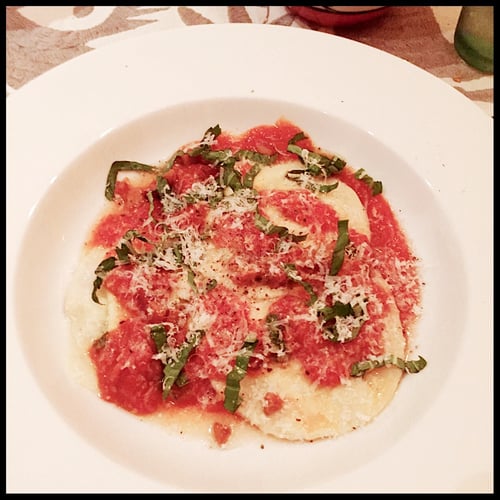
One of the coolest things about creating a pasta dish is that you can let your imagination run wild, which is what I’ve been doing a lot lately. I've been avoiding recipes and experimenting with a variety of ingredients, different shapes and sizes of pasta. Try different sauce methods, maybe a simple sauce of garlic, olive oil and butter. Or perhaps you like a more complex sauce that might include canned San Marzano tomatoes, several aromatics, red wine, fresh herbs and your favorite meat or shellfish. I’m really into using shrimp and scallops now. To this linguine, I added shrimp, scallops, tomato, shallot, heavy cream, vodka sauce, torn basil and grated Parmesan cheese.
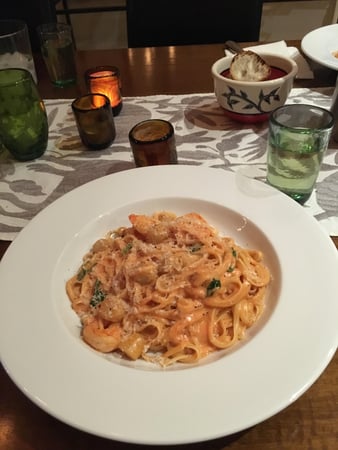 Let the pasta and your taste buds do the talking for you. If you need some additional inspiration, sign up for one of our popular Pasta Workshop cooking classes. We also have a gluten-free version of this class! If you love pasta as much as I do, you won't want to miss our Pasta Boot Camp in the fall.
Let the pasta and your taste buds do the talking for you. If you need some additional inspiration, sign up for one of our popular Pasta Workshop cooking classes. We also have a gluten-free version of this class! If you love pasta as much as I do, you won't want to miss our Pasta Boot Camp in the fall.

